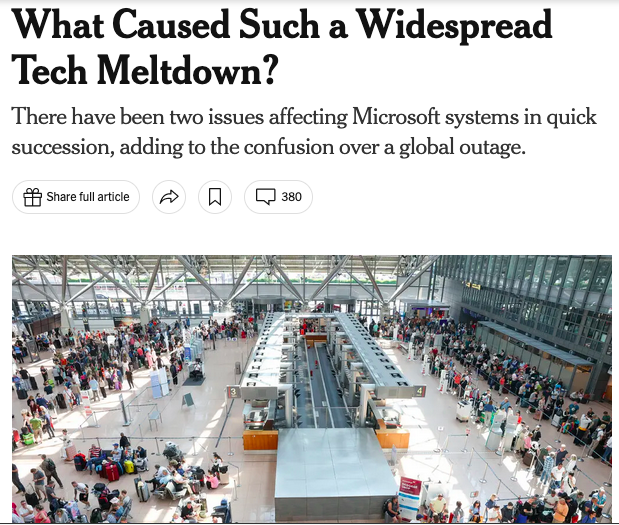
Major Cloud Services outages are becoming common place. The trend really started back in 2016, when massive cyber attacks targeting Amazon AWS took down huge portions of the internet, including services like NetFlix, Twitter, Amazon, etc.. Today, major cloud outages are common place, with almost 20 such serious outages being recorded in 2023, and that trend is continuing and escalating in frequency and severity in 2024.
So many big brands have become reliant on these hyperclouds, that effectively they have become a single point of failure for many organizations IT infrastructure and critical services delivery. A targeted attack against Amazon AWS can take down millions of organizations. A bad software update by Microsoft Azure can take down critical services and millions of users and organizations. For huge corporations, with massive budgets and teams, this is workable to a certain degree. They can continually invest more and more into their AWS or Azure architecture and design and work to bi-pass such issues or minimize their impact moving forward.
For the average SMB, Mid Market or Small Enterprise type of customer, the hyperclouds are becoming an untenable solution for their organizations. Often times lacking an adequate amount of inhouse resources &/or budget, along with a lack of any real support from the cloud vendors themselves, these organizations are at the mercy of these major cloud services providers if/when issues arise. Even organizations who have aligned with Azure or AWS partners or Managed Service Providers (MSP’s), are still ultimately at the mercy of the underlying infrastructure providers.
My own company (www.cartika.com) and companies like us have resisted moving our infrastructure and customers to the major hypercloud providers. Preferring instead to run our own infrastructure in commercially available Tier3+ to Tier4 datacenters. We are consistently delivering higher service uptimes, lower frequency of serious issues and faster/simpler recovery from service impacting issues when they do occur. With greater separation of customers within datacenters, and greater separation between customers within a specific providers footprint within datacenters, issues, when they occur, tend to occur less often, be less severe and impact less users for shorter periods of time. Whereas with these massive hypercloud providers, you often see entire datacenters go offline, and millions of users impacted for prolonged periods of time. Sometimes, as was the case with this most recent Azure issue, a single issue caused global level outages. I just don’t see how this approach is palatable for the typical business any longer. We do not have a single service reliant on the major cloud providers. All of our customers did not experience a single second of downtime today, or during any of the other serious outages seen on the major platforms over the last few years. As the CFO of one of our key customers told us today – reached out to me personally to tell me this – when they were previously on Azure, this sort of outage would have shut down production in all 8 of our factories. $100’s of $1000’s of dollars in direct losses each and every time they had Azure problems for the day. The indirect costs are incalculable. Their business just could not survive if these scenarios kept occurring.
Far too many organizations made the push to the massive hyperclouds – for what apparently was no other reason than everyone else is on AWS and Azure, we should be too. But, with the strain on resources, financial pressures and pressures to deliver quality and reliability of services being at an all time high, I think its becoming irresponsible for the typical mid market business to be relying on providers like AWS and Azure. I would expect more and more businesses to once again seek out high value services powered by smaller more niche providers, at significantly lower total cost of ownership, with a proven history of better reliability, uptime and performance – not too mention lower costs and significantly better overall value and higher levels of day to day support – as compared to the mega cloud providers. It is quickly becoming the only rational path forward for the typical mid market business.
Andrew Rouchotas
Cartika Founder & CEO
www.cartika.com

